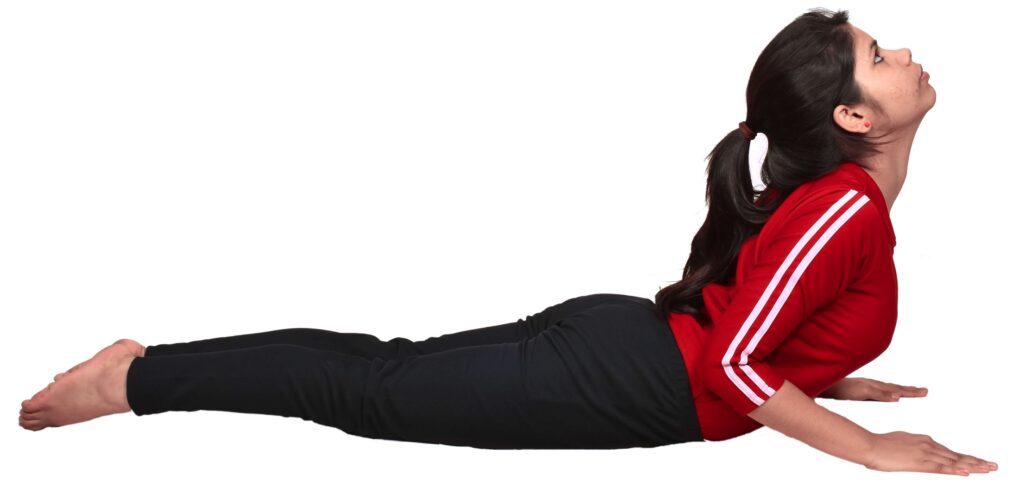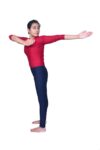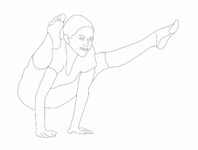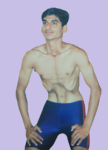Meaning of Bhujangasana
- Cobra pose is also known as Bhujangasana.
- Bhujangasana is a Sanskrit word.
- Bhujangasana is pronounced as ‘boo-jang-GAHS-anna’.
- Bhuja means ‘arm’ or ‘shoulder’, and Anga means ‘limb.’
- Bhujanga means ‘serpent’
- Bhujngasana emulates the mechanism of a cobra. That’s why it is also known as cobra pose.
- In the article, you will get information about easy and simple explanations of cobra poses, benefits, precautions, breathing patterns, top facts, muscular movements, etc., regarding Bhujangasana.
What is a Cobra Pose?
- Cobra pose is one of the essential prone yoga poses.
- It is called the cobra pose because it resembles and provides extra flexibility to the body, just like the cobra.
- It works upon nerves, the spine, and especially the back muscles in a very effective way. Therefore, it is called a boon for those who have back problems.
- The pose is helpful in the prevention and management of gynaecological disorders, kidney, slipped discs, respiratory problems, diabetes, etc.

Bhujangasana introduction
After much research and discussion with renowned yoga gurus, yoga teachers, and yoga experts, the article is being presented before you. Besides this, I am also sharing my personal experience after practising yoga for the last 20 years. You will get here to know what a cobra poses, how to do it, and its benefits and precautions. The easily explained steps, benefits, precautions, images, and videos of the cobra pose will help you to understand the posture technically correctly, thereby extracting maximum benefits from it.
How to do Bhujangasana step by step
Bhujangasana is a simple and easy yoga pose. Its more straightforward step-by-step technique has been mentioned below.
- Lie flat on the stomach, legs straight and toes pointed outward.
- Put your palms below the shoulders; arms should be bent with the elbows facing backwards.
- Rest the forehead on the ground and relax the body, especially the back.
- Inhale, raise the body to the navel and try to see the roof by bending your back backwards.
- Now, keep the back and legs as relaxed as possible.
- Do inhaling- exhaling slowly and deeply.
- Maintain the pose as long as you can.
- Exhale, bring your upper body down and come to the original position.
- This is the one round.
- Do 2-3 rounds.
Breathing Awareness and Duration
To get the best possible benefits of Bhujangasana, breathing awareness has to be taken care of. Try to focus on the body movement with the synchronisation of the breath. In all these, keep one thing in mind: the back should be relaxed and stress-free. During raising the upper body part, one should inhale. Slow and deep inhaling-exhaling should be done while holding the pose. Exhale, could you come to the original position? First, one must maintain it for 10-15 seconds and increase the duration according to your comfort and convenience. The recommended time to hold the pose is up to 3 minutes.
Muscular movement
It is one of the best yoga poses from a health point of view. It is said that the yoga pose facilitates benefits from head to toe. During the practice of cobra pose, various muscles experience stretching and compressing, viz., back, legs, knees, chest, neck, and arms. The abdominal muscles also experience stretching. The joints involved in the cobra pose are Spine extension, sacrum counternutation; hip extension, internal rotation, adduction, knee extension, ankle plantarflexion; scapula neutral (possibly upward rotation), glenohumeral joint external rotation, elbow extension, and forearm pronation.
Instructional video of cobra pose
-
The video of the Cobra pose has been made very simple and easy to help understand the practitioners.
-
It has been developed after the discussion with many yoga experts and teachers.
-
Extensive research has also been carried out while making the video.
- A glimpse of my vast year’s experience can also be seen there.
Video Source: Morarji Desai National Institute of Yoga
Cobra pose to practice in different schools of yoga
Bhujangasana has some variations in steps and techniques performed by renowned yoga experts and teachers. These other techniques by other schools of yoga while practising the cobra pose are given below.
- Iyengar yoga: In the Iyengar school of yoga, the head is not bent backwards but straight upward. The navel is above the surface, and the pose looks precisely like a cobra.
- Vinyasa yoga: It is similar to Iyengar yoga.
- Ashtanga yoga: It is similar to the technique mentioned above.
- Baba Ramdev yoga: Baba Ramdev lifts the entire body on its palms and toes.
- Art of living: It resembles Ashtanga yoga, but the head is not so much bent backwards.
- Power yoga: The main focus is stretching and the rigourness of the posture.
- Hot yoga: It is similar to power yoga but more strenuous.
- Satyananda yoga: It is similar to Ashtanga yoga.
- Bikram yoga: It is similar to the technique mentioned above in the article.
10 health benefits of Bhujangasana
Some of the essential benefits of Bhujangasana are given below.
- Weight Loss: The cobra pose can effectively manage weight loss by burning belly fat and extra fats ranging from head to toe as the pose provides adequate stretching to the entire body. It can make your stomach flat.
- Sexual disorders: It is said that all women should perform the cobra pose because it is helpful to many women’s health-related issues. It is beneficial in case of gynaecological problems like leucorrhea, dysmenorrhea, syphilis, amenorrhea, etc. It is also suitable for the health of the ovary and uterus and a smooth menstrual cycle.
- Back pain: It is a panacea for those who are having back pain. The Asana has the power to eradicate back-related issues. Practising the yoga pose provides suitable stretch and increases flexibility to the back muscles and the entire vertebral column, thus relieving backache and pains related to the spine and vertebral column.
- Kidney health: The asana helps the kidneys to purify the blood. The asana compressed the kidney, thereby removing stagnant blood. Thus, the cobra pose enhances the efficiency of the kidneys.
- Thyroid disorders: It positively impacts the thyroid and parathyroid glands. If the asana is practised therapeutically, it helps to release thyroxin hormone, which helps relieve thyroid problems symptoms. Neck pain also gets relief.
- Chest expansion: The regular use of the asana ensures chest expansion and better exchange of oxygen-carbon dioxide, thereby helpful in treating respiratory congestion and asthma-related problems.
- Sciatic: If the sciatic patients practised the asana in the presence of a yoga therapist, the sciatic condition can be solved permanently. It is also suitable for slipped discs.
- Pelvic health: It ensures smooth blood flow to the pelvic region, thus good for pelvic health.
- Kundalini activation: The asana practice develops better coordination among plexuses, nerves, and muscles, stimulating Kundalini.
- Rheumatism: The cobra pose ensures the secretion of cortisone, which is effective in curing rheumatism.
Contraindications
Some of the few precautions/limitations of Bhujangasana are:
- Pregnancy
- Peptic ulcer
- Intestinal tuberculosis
- Hyperthyroidism
- Fracture ribs
- Wrists problems
- Abdominal surgery
- Hernia
- Headache
- Sever back pain
- Migraine
- Shoulder and elbow injury
Beginner’s tip
Initially, one shouldn’t start to perform the pose as mentioned above. In the beginning stage, raise your head and chest per your comfort. Gradually, it moves towards the advanced stage, considering the flexibility of your back. Practice the more straightforward version before performing the advanced pose for at least one month.
Cobras pose sequence
Preparatory pose
- Tadasana
- Stickasana
- Triangle pose
- Shalbhasana
Follow-up / counterpose
- Ardha halasana
- Setu Bandhasana
- Pawanmuktasana
Top 10 Facts about Bhujangasana
Here, we will mention the points to be remembered, tips, and mistakes to avoid while doing the yoga pose.
- The navel should be in contact with the ground; if the navel is raised too high, the bend tends to be at the knees instead of the back.
- Try to keep your facial muscles relaxed
- The mouth should be closed.
- If somebody feels a soothing, painful sensation in the lower back, you do the asana correctly.
- The abdomen shouldn’t be off the ground.
- The hands should be placed beside the shoulder.
- Hold your head as far back as possible.
- Don’t push your back to make the arch. Perform the asana with a relaxed body and mind.
- The feet should be firmly on the ground, and the toes should be pointed outward.
- Patients with slipped discs and sciatica should always practice it under yoga experts’ supervision.
The Science Behind Bhujangasana
The adrenal glands on the top of the kidneys receive an excellent massage, thus enhancing their efficiency. The hormones these glands produce balance our mind and body, thus relieving tension. Cortisone hormone secreted by the adrenal glands is found helpful in rheumatism. The asana helps to squeeze out stagnant blood, thus toning up the nerves and muscles of the back region.
Modification and variations
- Cobra pose (Saral Hasta Bhujangasana
- Curved hands cobra pose (Vakra Hasta Bhujangasana)
- Ardha Bhujangasana (Half cobra pose)
- Cobra pose with raising palm







1 thought on “How To Do Bhujangasana-Steps, Benefits And Precautions”